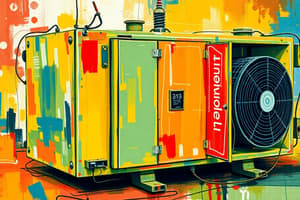Podcast
Questions and Answers
What is the primary function of the converter at the line-end in wind-electric systems?
What is the primary function of the converter at the line-end in wind-electric systems?
- To convert AC voltage to DC voltage
- To generate a high-voltage DC output
- To regulate the wind speed
- To absorb or supply reactive power in a continuous manner (correct)
What is the typical output voltage range of the PV arrays in photovoltaic systems?
What is the typical output voltage range of the PV arrays in photovoltaic systems?
- 120-V to 240-V AC
- 52-V to 90-V DC (correct)
- 480-V to 600-V AC
- 240-V to 480-V DC
What is the primary advantage of photovoltaic systems over wind-electric systems?
What is the primary advantage of photovoltaic systems over wind-electric systems?
- Greater potential for distributed generation (correct)
- Higher power output capacity
- Higher efficiency
- Lower cost of power electronic interfaces
What is the purpose of the power electronic system in photovoltaic systems?
What is the purpose of the power electronic system in photovoltaic systems?
What is the typical input to a fuel cell system?
What is the typical input to a fuel cell system?
What is the maximum efficiency of a fuel cell system?
What is the maximum efficiency of a fuel cell system?
What is the primary reason for using power electronic converters in fuel cell systems and photovoltaic systems?
What is the primary reason for using power electronic converters in fuel cell systems and photovoltaic systems?
Why is a power-electronic interface necessary in micro-turbine systems?
Why is a power-electronic interface necessary in micro-turbine systems?
What is the primary benefit of energy storage systems in power systems?
What is the primary benefit of energy storage systems in power systems?
What type of energy storage system requires a power electronic interface, as shown in Figure 10?
What type of energy storage system requires a power electronic interface, as shown in Figure 10?
What is an example of poor power quality?
What is an example of poor power quality?
What is the primary purpose of a power-electronic interface in power systems?
What is the primary purpose of a power-electronic interface in power systems?
What are the main power system components?
What are the main power system components?
What is the primary function of a series capacitor in a power system?
What is the primary function of a series capacitor in a power system?
What type of power electronic device is used for shunt-compensation and injecting reactive power for voltage control?
What type of power electronic device is used for shunt-compensation and injecting reactive power for voltage control?
What is the main advantage of using a phase shifting transformer in a power system?
What is the main advantage of using a phase shifting transformer in a power system?
What is the primary function of a synchronous condenser in a power system?
What is the primary function of a synchronous condenser in a power system?
What is the main characteristic of a solid-state switch in a power system?
What is the main characteristic of a solid-state switch in a power system?
Flashcards are hidden until you start studying
Study Notes
Power Electronics in Power Systems
- Power electronics converters are necessary to interface with the utility for fuel cell systems and photovoltaic systems.
Micro-Turbines
- Micro-turbines use highly efficient aircraft engines with natural gas as the input fuel.
- To improve efficiency, the turbine speed should be allowed to vary based on loading.
- This causes the frequency of the generated output to vary, requiring a power-electronic interface.
Energy Storage Systems
- Energy storage systems offer benefits such as load-leveling and peak-shaving in power systems.
- Energy is stored, usually at night when the load demand is low, and supplied back during peak-load periods.
- Energy can be stored in lead-acid batteries, Super-conducting Magnetic Energy Storage (SMES) coils, and in the inertia of flywheels.
Power Quality Solutions
- Poor quality of power can imply distorted voltage waveforms, unbalances, swells and sags in voltage, power outages, and more.
Main Power System Components
- Transmission bottlenecks must be identified when operating electrical power systems, including:
- Steady-State Power Transfer Limit
- Voltage Stability Limit
- Transient Stability Limit
- Thermal Limit
- Short-Circuit Current Limit
Conventional System Solutions
- Conventional systems enhance transmission capability by:
- Series Capacitors (X)
- Switched Shunt-Capacitor and Reactor (V drop solution)
- Transformer Tap-changer LTC’s (V drop solution)
- Phase Shifting Transformers (δ – power transmission)
- Synchronous Condensers (V - drop solution)
Categorizing Power Electronic Systems
- Power electronic systems can be categorized as:
- Solid-State Switches
- By connecting two thyristors in anti-parallel (back-to-back) as shown in Figure, a solid-state switch can be realized that can conduct current in both directions and turn-on or off in an ac circuit with a delay less than one-half a cycle.
Photovoltaic (PV) Systems
- Photovoltaic systems are the ultimate in distributed generation and have a greater potential than wind-electric systems.
- PV arrays provide a voltage of 52-V to 90-V DC, which the power electronic system converts to 240 V/50 Hz sinusoidal voltage suitable for interfacing with the single-phase utility.
Fuel Cell Systems
- The input to the fuel cell can be hydrogen, natural gas, or gasoline, and the output is a dc voltage.
- The efficiency of fuel cell systems can be as high as 60%.
Studying That Suits You
Use AI to generate personalized quizzes and flashcards to suit your learning preferences.




